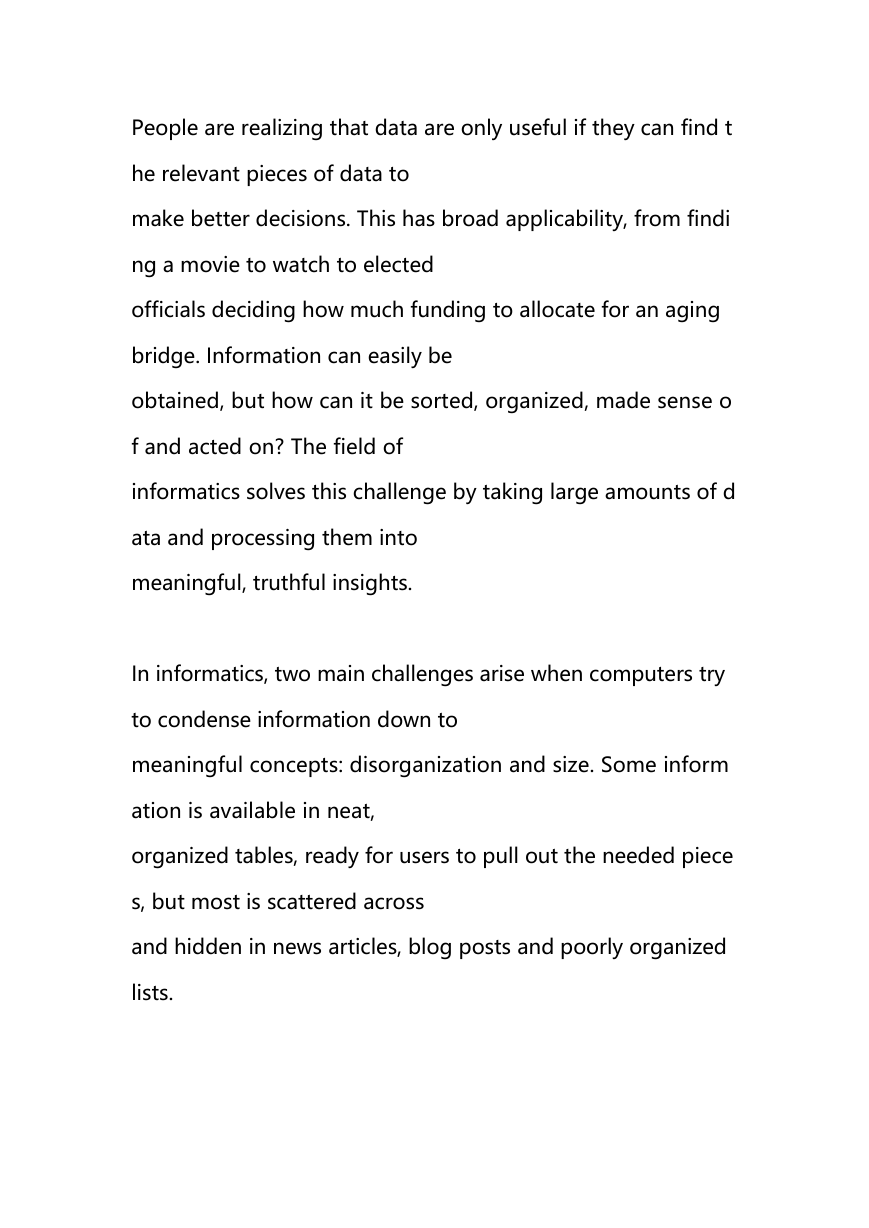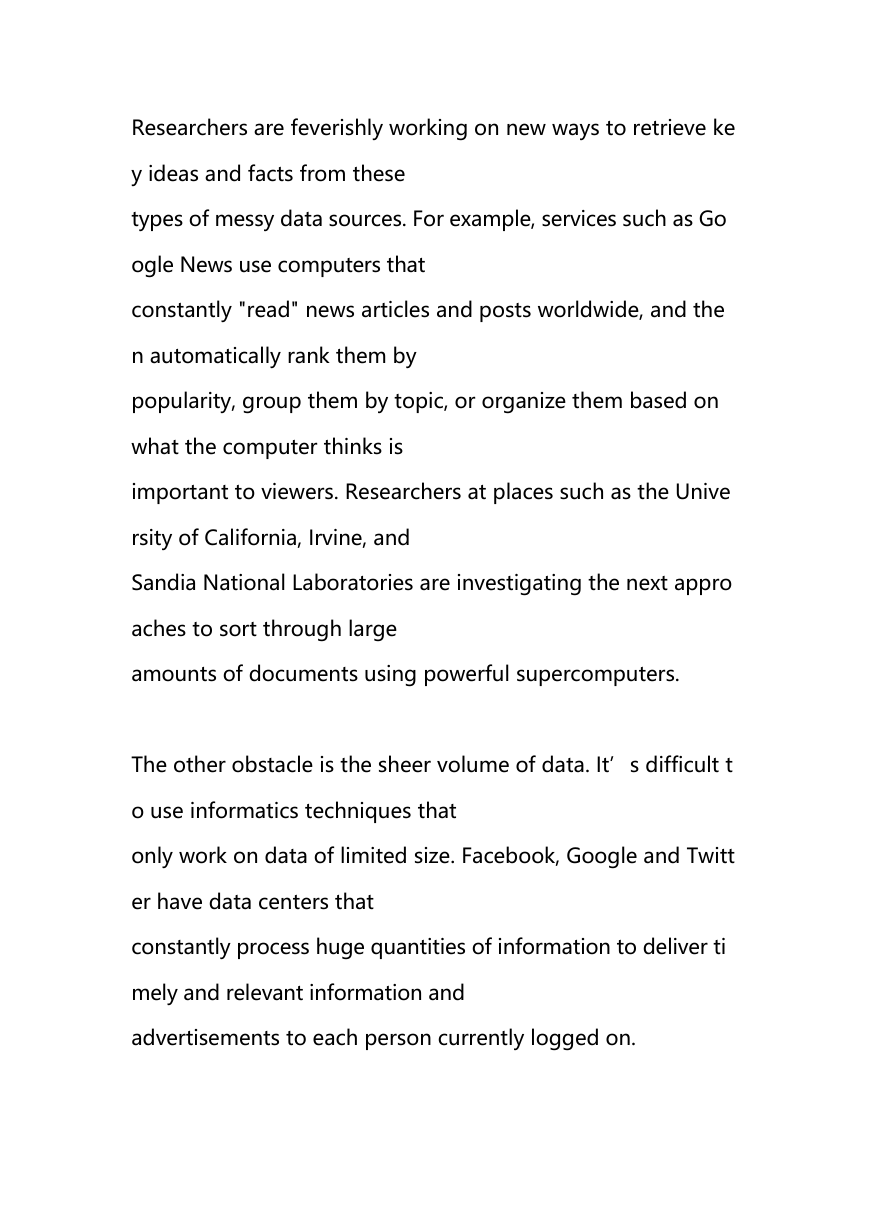Is What You See, What You Get? Geospatial
Visualizations Address Scale and Usability
AashishChaudharyandJeffBaumes
U
nlimited geospatial information now is at everyone’s fingerti
ps with the proliferation of
GPS-embedded mobile devices and large online geospatial d
atabases. To fully understand
these data and make wise decisions, more people are turnin
g to informatics and geospatial
visualization, which are used to solve many real-world proble
ms.
To effectively gather information from data, it’s critical to ad
dress scalability and intuitive user
interactions and visualizations. New geospatial analysis and vi
sualization techniques are being
used in fields such as video analysis for national defense, urb
an planning and hydrology.
Why Having Data Isn’t Good Enough Anymore
�
People are realizing that data are only useful if they can find t
he relevant pieces of data to
make better decisions. This has broad applicability, from findi
ng a movie to watch to elected
officials deciding how much funding to allocate for an aging
bridge. Information can easily be
obtained, but how can it be sorted, organized, made sense o
f and acted on? The field of
informatics solves this challenge by taking large amounts of d
ata and processing them into
meaningful, truthful insights.
In informatics, two main challenges arise when computers try
to condense information down to
meaningful concepts: disorganization and size. Some inform
ation is available in neat,
organized tables, ready for users to pull out the needed piece
s, but most is scattered across
and hidden in news articles, blog posts and poorly organized
lists.
�
Researchers are feverishly working on new ways to retrieve ke
y ideas and facts from these
types of messy data sources. For example, services such as Go
ogle News use computers that
constantly "read" news articles and posts worldwide, and the
n automatically rank them by
popularity, group them by topic, or organize them based on
what the computer thinks is
important to viewers. Researchers at places such as the Unive
rsity of California, Irvine, and
Sandia National Laboratories are investigating the next appro
aches to sort through large
amounts of documents using powerful supercomputers.
The other obstacle is the sheer volume of data. It’s difficult t
o use informatics techniques that
only work on data of limited size. Facebook, Google and Twitt
er have data centers that
constantly process huge quantities of information to deliver ti
mely and relevant information and
advertisements to each person currently logged on.
�






 2023年江西萍乡中考道德与法治真题及答案.doc
2023年江西萍乡中考道德与法治真题及答案.doc 2012年重庆南川中考生物真题及答案.doc
2012年重庆南川中考生物真题及答案.doc 2013年江西师范大学地理学综合及文艺理论基础考研真题.doc
2013年江西师范大学地理学综合及文艺理论基础考研真题.doc 2020年四川甘孜小升初语文真题及答案I卷.doc
2020年四川甘孜小升初语文真题及答案I卷.doc 2020年注册岩土工程师专业基础考试真题及答案.doc
2020年注册岩土工程师专业基础考试真题及答案.doc 2023-2024学年福建省厦门市九年级上学期数学月考试题及答案.doc
2023-2024学年福建省厦门市九年级上学期数学月考试题及答案.doc 2021-2022学年辽宁省沈阳市大东区九年级上学期语文期末试题及答案.doc
2021-2022学年辽宁省沈阳市大东区九年级上学期语文期末试题及答案.doc 2022-2023学年北京东城区初三第一学期物理期末试卷及答案.doc
2022-2023学年北京东城区初三第一学期物理期末试卷及答案.doc 2018上半年江西教师资格初中地理学科知识与教学能力真题及答案.doc
2018上半年江西教师资格初中地理学科知识与教学能力真题及答案.doc 2012年河北国家公务员申论考试真题及答案-省级.doc
2012年河北国家公务员申论考试真题及答案-省级.doc 2020-2021学年江苏省扬州市江都区邵樊片九年级上学期数学第一次质量检测试题及答案.doc
2020-2021学年江苏省扬州市江都区邵樊片九年级上学期数学第一次质量检测试题及答案.doc 2022下半年黑龙江教师资格证中学综合素质真题及答案.doc
2022下半年黑龙江教师资格证中学综合素质真题及答案.doc